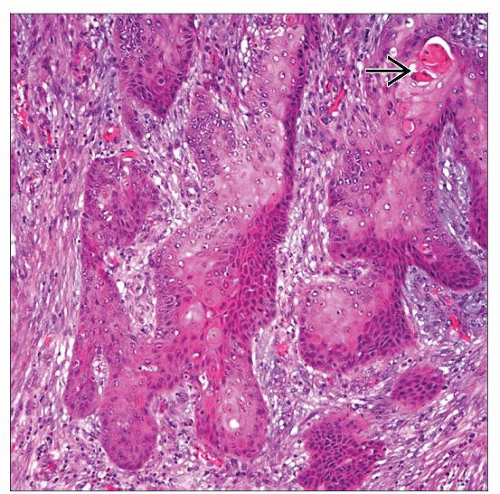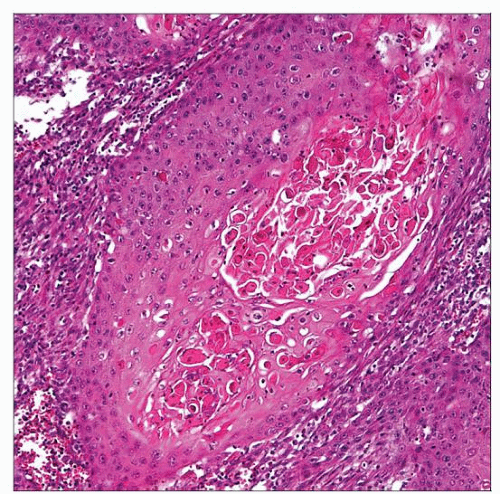Invasive Squamous Cell Carcinoma
Jesse K. McKenney, MD
Key Facts
Terminology
Malignant epithelial neoplasm of bladder with pure squamous cell phenotype
Etiology/Pathogenesis
Chronic inflammatory conditions with squamous metaplasia are risk factors
Strongly associated with Schistosoma infection
Clinical Issues
Varies with geographic region (incidence higher in areas of endemic schistosomiasis)
Hematuria
Dysuria
Radical cystectomy is standard therapy
Microscopic Pathology
Typical/classic squamous cell carcinoma
Irregular jagged invasive aggregates distributed randomly in lamina propria
By definition, no component of urothelial carcinoma is present
Verrucous carcinoma
Verrucous fronds of well-differentiated, acanthotic squamous epithelium with hyperkeratosis
Sharp rounded “pushing” base at junction with lamina propria
Minimal cytologic atypia
Almost exclusively associated with Schistosoma infection
Top Differential Diagnoses
Invasive urothelial carcinoma with squamous differentiation
Metastatic or secondary squamous cell carcinoma
TERMINOLOGY
Abbreviations
Squamous cell carcinoma (SCC)
Definitions
Malignant epithelial neoplasm of bladder with pure squamous cell phenotype
ETIOLOGY/PATHOGENESIS
Developmental Anomaly
Bladder exstrophy
Environmental Exposure
Associated with tobacco smoking
5x increased risk over nonsmokers
Infectious Agents
Chronic inflammatory conditions with squamous metaplasia are risk factors
Bladder stones
Chronic indwelling catheters
Neurogenic bladder
Prolonged cyclophosphamide treatment
Strongly associated with schistosomal infection
Includes Schistosoma haematobium and Schistosoma mansoni
Common in Egypt and Sudan
Verrucous carcinoma is more specifically associated with Schistosoma infection
HPV association is probably very rare
May be seen in cases associated with condyloma
CLINICAL ISSUES
Epidemiology
Incidence
Varies by geographic region (incidence higher in areas with endemic schistosomiasis)
5% of bladder tumors in USA
75% in Egypt/Sudan (bladder cancer represents 1/3 of all cancers in Egypt)
Verrucous carcinoma of urinary bladder is very rare in USA
3% of bladder cancers in regions of endemic schistosomiasis
Age
Most common in 6th decade
Gender
Male predominance, but lower than in urothelial carcinoma
Presentation
Hematuria
Dysuria
Endoscopic Findings
Large white exophytic mass
Surface of bladder may show white, plaque-like thickening
Treatment
Surgical approaches
Radical cystectomy is standard therapy
Adjuvant therapy
Often have neoadjuvant or adjuvant radiation
Adjuvant chemotherapy is less standardized
Prognosis
Poor prognosis (nonverrucous SCC)
High-stage disease at presentation is common
Reported 5-year survival = 7-50%
Survival in pT3 disease = 13%
Pure verrucous carcinoma has favorable prognosis with no metastatic risk
MACROSCOPIC FEATURES
General Features
Fungating, tan-white mass
Often ulcerated and necrotic
Typically large and deeply invasive
MICROSCOPIC PATHOLOGY
Invasive Squamous Cell Carcinoma, Typical/Classic Type
Irregular jagged invasive aggregates of malignant squamous cells distributed randomly in lamina propria
Associated stromal myofibroblastic proliferation common
Displays range of differentiation
Well differentiated: Keratinization, prominent intercellular bridges, and minimal nuclear pleomorphism
Stay updated, free articles. Join our Telegram channel

Full access? Get Clinical Tree





